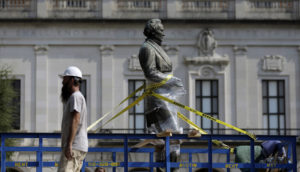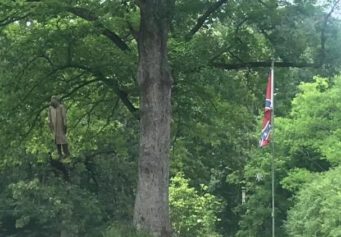
A statue of Confederate President Jefferson Davis is moved from its location in front of the school’s main tower the University of Texas campus, Sunday, Aug. 30, 2015, in Austin, Texas. (AP Photo/Eric Gay)
Dylann Roof, the gunman who massacred nine Black churchgoers in Charleston, hoped to set off a race war, but his actions had the opposite effect. Across the South, states have finally decided to stop flying the rebel flag, which Roof had prominently displayed. And it’s not just the flag, it’s also other symbols of the Confederacy.
The University of Texas (UT) at Austin has removed a statue of Jefferson Davis, president of the Confederacy. University authorities decided to move the statue from a place near the clocktower to a museum, after a last-minute appeal by a Confederate heritage group failed. UT also voted to remove the statue of former President Woodrow Wilson. Wilson screened the racist film, Birth of a Nation, at the White House and also ordered the segregation of federal offices, restrooms and cafeterias. The student body voted to move the statue in March.
Kirk Lyons, a lawyer representing the Texas Division of the Sons of Confederate Veterans, described the removal of the statue as an “ISIS-style cleansing of history.” David Steven Littlefield, a relative of George Littlefield, who commissioned the statue, said the decision was taking political correctness too far.
“I think it’s just absolutely silly for them to move those statues based on someone being offended,” said Littlefield during the trial.
However, some UT alumni said the statue should have been removed a long time ago.
“I think it’s a good idea,” said Sandra Bieri, a 1961 UT graduate and retired law firm librarian. “It’s overdue.”
“This is an iconic moment,” said Gregory Vincent, the university’s vice-president for diversity and community engagement, said in The Austin American Statesman. “It really shows the power of student leadership.”
UT’s Briscoe Center of American History hosts one of the nation’s largest archives on slavery.
“Putting [the statue] in the Briscoe Center, is far from whitewashing or erasing history, but puts it in the proper historical context,” Vincent told The Associated Press.
The statue of Davis was controversial and was targeted by vandals several times. The words “black lives matter” were scrawled at the base of the statue in June. The statue of Davis had stood on the UT campus for 82 years. The campus also features several other Confederate heroes such as generals Robert E. Lee and Albert Sidney Johnston, as well as Confederate postmaster general John Reagan. The Austin-American Statesman said UT was heavily influenced by one of it’s early benefactors, George Washington Littlefield, who was a Confederate officer and later a UT regent. The UT at Austin has an ugly racial history. The university didn’t admit Black students until ordered by a 1950 U.S. Supreme Court ruling.
The statue of Davis was met with controversy when it was originally designed.
“As time goes by, they will look to the Civil War as a blot on the pages of American history, and the Littlefield Memorial will be resented as keeping up the hatred between the Northern and Southern states,” said sculptor Pompeo Coppini.
The University of Texas at Austin is not the only college trying to change its ugly racial history. Yale is reportedly considering changing the name of a residential college named after John C. Calhoun, a former vice president and South Carolina senator, who was an ardent supporter of slavery.
The issue was raised this summer when a petition was circulated in the wake of the Charleston massacre. The petition said having the college named after Calhoun represents “an indifference to centuries of pain and suffering among the black population.”
President Peter Salovey and Dean Jonathan Holloway told alumni they weren’t taking a position on the issue, but urged new students to take part in the discussion.
Holloway, a scholar of African-American history, said the nation had a complicated racial past. According to Huff Post, Holloway said Elihu Yale, the university’s benefactor, never owned slaves, but likely profited from the slave trade.


